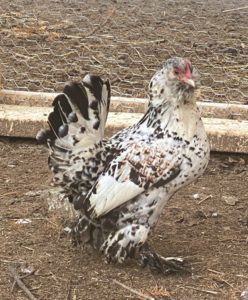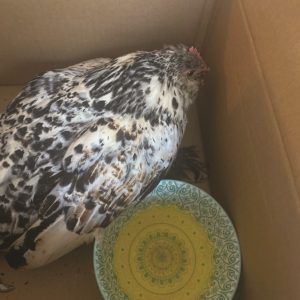When we started keeping chickens, we kept them in a fortress-like coop with a luxuriously large, protected run. I didn’t want our hens to be deprived of space. But I certainly was not going to let them roam within reach of predators.
I’d heard lots of stories. It seemed that every one of my neighbors with a flock had lost at least a few chickens. Foxes, raccoons, coyotes, and hawks were most often the culprits. Our backyard farm would be different, I thought.

Now, we let our ladies range in our yard on sunny days, when we are home. I have my reasons: The yard is completely enclosed by a wooden fence. They get so much more exercise when they roam. It’s fun to be followed around by curious hens when you hang out the laundry or crisscross the yard on other errands. And it just feels wrong to deprive our birds of freedom.
It was actually the loss of a hen that got me to this new, free-ranging place. One of our ladies was sunning herself in a corner of the enclosure when a hawk came along and got her by the neck, right through the chicken wire.
Aware of the limitations of our fortress, I found myself leaving the door to the run open during the day. (At dusk, the hens march themselves back to the coop to roost.) I wanted our flock to have a taste of the good life. Which, for a chicken, includes scratching in the dirt, pecking at blades of grass, chasing other chickens across a stretch of yard, and even flying up to perch on a tree branch.
The better they know the yard, I imagine, the better they will get at finding hiding places. And chickens are made to be on the lookout for predators. Since their eyes are on either side of their heads, they have a 300-degree field of vision. They can see subtle changes in light, shadow, and motion. And they have monovision, so they can cast a farsighted left eye to the sky to be on the lookout for hawks.
Not that I let my guard down completely. I recently made two scarecrows. Wearing bright, aged-out coats, they are in a perpetual dance in our yard, silent guardians when our chickens are out. My hope is that they’ll fool the hawks.
A couple of weeks ago, I was writing at my kitchen table when I heard a screech and saw a stampede of chickens making it for the open door of our chicken house. I ran out in a panic to find Featherfoot Freckles pinned to the ground, in the talons of a Cooper’s hawk. Its wings were spread for flight.
Red-tailed and Cooper’s hawks are the species most likely to hunt hens on the Outer Cape. The Cooper’s is smaller, common to wooded habitats. They hunt during the day and will observe a flock from a hidden spot in a tree before swooping down to grab a hen.
Often, the Cooper’s hawk’s prey does not survive the initial impact. The hawk can fly off with a meal in its talons without leaving a trace.

This particular hawk had picked an easy prey. Freckles is a Bantam Brahma, a miniature breed with feathered feet. Bantams tend to waddle rather than run, making them slower and easier to catch than their larger sisters.
Startled by my cries and waving arms, the Cooper’s rose without Freckles. But my little Featherfoot looked a pitiful mess, with one bloody wing splayed out on the ground. When I picked her up gently, she was alive but in shock. I was sure she was dying and brought her in to wait for Russell to lend a hand.
There are few veterinarians on the Cape, and even fewer who work with farm animals. Don’t expect a vet to offer much help for an injured chicken. We placed Freckles inside a small carrier and kept her in a quiet, warm spot near us. For her pain, we offered her a low dose of aspirin dissolved in a bowl of water.
The next day brought a promising change. Freckles was alert when we held her, and we couldn’t find serious wounds when we examined her wings and body. (Unless a chicken is bleeding, it’s better to wait until she is not in shock before checking her out.)
The next day, Freckles rejoined the flock. Yes, out in the yard. With her left eye to the sky.



